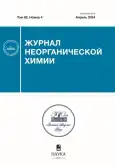Sol-gel synthesis, structure and adsorption properties of LiMgxMn(2-x)O4 (0 ≤ x ≤ 0.7) Oxides
- Authors: Begimkulova S.A.1, Nasimov A.M.1, Ruzimuradov O.N.2, Prozorovich V.G.3, Ivanets A.I.3
-
Affiliations:
- Rashidov Samarkand State University
- Turin Polytechnic University in Tashkent
- Institute of General and Inorganic Chemistry of the National Academy of Sciences of Belarus
- Issue: Vol 69, No 4 (2024)
- Pages: 537-545
- Section: ФИЗИКОХИМИЯ РАСТВОРОВ
- URL: https://gynecology.orscience.ru/0044-457X/article/view/666569
- DOI: https://doi.org/10.31857/S0044457X24040092
- EDN: https://elibrary.ru/ZYGFQZ
- ID: 666569
Cite item
Abstract
Lithium manganese оxides with a spinel structure LiMgxMn(2–x)O4, doped with Mg2+ ions in the range 0 ≤ x ≤ 0.7, were obtained by sol-gel synthesis. Phase composition and morphology of obtained оxides were studied by using X-ray phase analysis and scanning electron microscopy. It is shown, that in the studied range 0 ≤ x ≤ 0.7 Mg-doped lithium manganese оxides saved the structure of the original cubic spinel LiMn2O4, while an increase in parameter a was observed from 8.175 to 8.309 Å and average crystallite size practically unchanged (30–36 nm). Samples of the initial LiMn2O4 and Mg-doped spinels were represented by prismatic particles of submicron (0.1–0.2 µm) and micron (1.0–3.0 µm) sizes, respectively. The effect of the adsorbent dose (0.05–0.3 g/l) and pH (3.0–13.0) of the solution on the adsorption efficiency was studied. The adsorption isotherms of the LiMg0.3Mn1.7O4 samples were described by the Langmuir monomolecular adsorption equation. An increase in the temperature of the model solution from 25 to 45°C was accompanied by an increase in the maximum adsorption of the LiMg0.3Mn1.7O4 samples from 10.50 to 10.98 mmol/g, which indicates the endothermic nature of the adsorption process. The kinetics of adsorption was well described by a pseudo-second order equation, which indicates the occurrence of chemical interaction during the adsorption process.
Keywords
Full Text
About the authors
Sh. A. Begimkulova
Rashidov Samarkand State University
Author for correspondence.
Email: bshahnoza0206@gmail.com
Uzbekistan, Samarkand, 140100
A. M. Nasimov
Rashidov Samarkand State University
Email: bshahnoza0206@gmail.com
Uzbekistan, Samarkand, 140100
O. N. Ruzimuradov
Turin Polytechnic University in Tashkent
Email: bshahnoza0206@gmail.com
Uzbekistan, Tashkent, 100095
V. G. Prozorovich
Institute of General and Inorganic Chemistry of the National Academy of Sciences of Belarus
Email: bshahnoza0206@gmail.com
Belarus, Minsk, 220072
A. I. Ivanets
Institute of General and Inorganic Chemistry of the National Academy of Sciences of Belarus
Email: bshahnoza0206@gmail.com
Belarus, Minsk, 220072
References
- Liu D.-F., Sun Sh.-Y., Yu J.-G. // Chem. Eng. J. 2019. V. 377. P. 119825. https://doi.org/10.1016/j.cej.2018.08.211
- Ryu J.Ch., Shin J., Lim Ch. et al. // Hydrometallurgy. 2022. V. 209. P. 105837. https://doi.org/10.1016/j.hydromet.2022.105837
- Zhang G., Zhang J., Zeng J. et al. // Coll. Surf. A. 2021. V. 629. P. 127465. https://doi.org/10.1016/j.colsurfa.2021.127465
- Tan L., Li Zh., Tong Zh. et al. // Ceram. Int. 2024. V. 50. № 4. P. 5877. https://doi.org/10.1016/j.ceramint.2023.11.386
- Tomon Ch., Sarawutanukul S., Phattharasupakun N. et al. // Commun. Chem. 2022. V. 5. P. 54. https://doi.org/10.1038/s42004-022-00670-y
- Qiu Y., Peng X., Zhou L. et al. // Batteries. 2023. V. 9. № 2. P. 123. https://doi.org/10.3390/batteries9020123
- Weng D., Duan H., Hou Y. et al. // Prog. Nat. Sci.: Mater. Int. 2020. V. 30. № 2. P. 139. https://doi.org/10.1016/j.pnsc.2020.01.017
- Cheng M., Yao Ch., Su Y. et al. // Chemosphere. 2021. V. 279. P. 130487. https://doi.org/10.1016/j.chemosphere.2021.130487
- Gao Y., Wang Sh., Gao F. et al. // Microporous Mesoporous Mater. 2023. V. 351. P. 112492. https://doi.org/10.1016/j.micromeso.2023.112492
- Gao J.-M., Du Z., Zhao Q. et al. // J. Mater. Res. Technol. 2021. V. 13. P. 228. https://doi.org/10.1016/j.jmrt.2021.04.073
- Liu Zh., Chen K., Ding J. et al. // Hydrometallurgy. 2023. V. 219. P. 106078. https://doi.org/10.1016/j.hydromet.2023.106078
- Siekierka A. // Sep. Purif. Technol. 2020. V. 236. P. 116234. https://doi.org/10.1016/j.seppur.2019.116234
- Tian G., Gao J., Wang M. et al. // Electrochim. Acta. 2024. V. 475. P. 143361. https://doi.org/10.1016/j.electacta.2023.143361
- Singh G., Gupta S.L., Prasad R. et al. // J. Phys. Chem. Solids. 2009. V. 70. № 8. P. 1200. https://doi.org/10.1016/j.jpcs.2009.07.001
- Llusco A., Grageda M., Ushak S. // Nanomaterials. 2020. V. 10. № 7. P. 1409. https://doi.org/10.3390%2Fnano10071409
- Ross N., Willenberg Sh., Juqu Th. et al. // J. Nanotechnol. 2024. V. 2024. P. 7020995. https://doi.org/10.1155/2024/7020995
- Zhan H., Qiao Y., Qian Zh. et al. // J. Ind. Eng. Chem. 2022. V. 114. P. 142. https://doi.org/10.1016/j.jiec.2022.07.003
- Park S. H., Yan Y.-Zh., Kim J. et al. // Hydrometallurgy. 2022. V. 208. P. 105812. https://doi.org/10.1016/j.hydromet.2021.105812
- Bao L.-R., Zhang J.-Z., Tang W.-P. et al. // Desalination. 2023. V. 546. P. 116196. https://doi.org/10.1016/j.desal.2022.116196
- Sun Y., Wang Q., Wang Y. et al. // Sep. Purif. Technol. 2021. V. 256. P. 117807. https://doi.org/10.1016//j.seppur.2020.117807
- Karshyga Z., Yersaiynova A., Yessengaziyev A. et al. // Materials. 2023. V. 16. № 24. P. 7548. https://doi.org/10.3390%2Fma16247548
- Иванец А.И., Печенка Д.В., Прозорович В.Г. и др. // Докл. НАН Беларуси. 2023. Т. 67. № 1. С. 27. https://doi.org/10.29235/1561-8323-2023-67-1-27-37
- Бузанов Г.А., Нипан Г.Д., Жижин К.Ю. и др. // Журн. неорган. химии. 2017. Т. 62. № 5. С. 551.
- Ivanets A., Prozorovich V., Kouznetsova T. et al. // J. Hazard. Mater. 2021. V. 411. P. 124902. https://doi.org/10.1016/j.jhazmat.2020.1249023
- Tran H.N., You Sh.-J., Hosseini-Bandegharaei A. et al. // Water Res. 2017. V. 120. P. 88. https://doi.org/10.1016/j.watres.2017.04.014
Supplementary files












